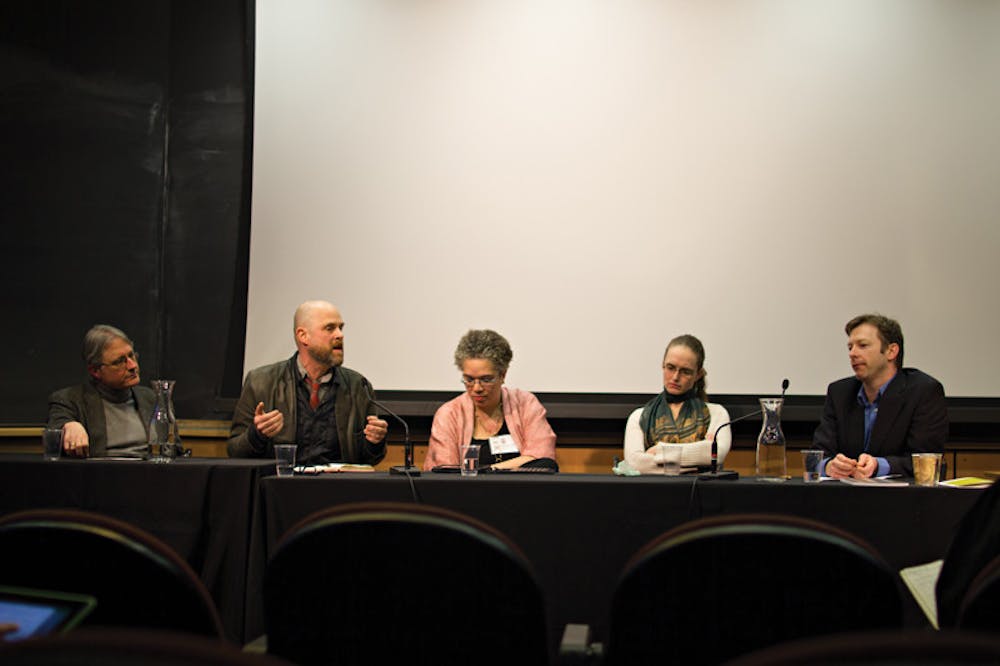Mingling over tea and cookies quickly turned into heated debate over the nature of neuroscience’s role in explaining aesthetic experience on Saturday, as a group of experts spoke at a day-long conference, “Neuroscience, Cognition, and the Arts.”
The conference, organized by English Professor Paul Armstrong and Vanessa Ryan, associate dean of the Graduate School and assistant professor of English, featured five speakers from different universities and diverse disciplines.
Just before 10 a.m., a primarily adult audience of professors and faculty members from a number of universities filled Smith-Buonanno Hall 106 as Ryan introduced the event as one intended to “foster cross-disciplinary dialogue.” She and Armstrong were “eager to spark conversations,” she said, adding that the recruited speakers were selected for being “exemplary at communicating their work,” especially to those less familiar with the fields.
Gabrielle Starr, professor of English and dean of the College of Arts and Science at New York University, kicked off the conference with a presentation on “programmatic neuroaesthetics.”
Starr, who has studied the neuroscience of aesthetics for the past seven years, told The Herald that her work focuses on brain responses to music, writing and visual art. During her presentation, she touched on positive and negative emotion factors, individual differences in aesthetic experience, the reward element and the movement and motor properties at play when one observes art.
Following Starr’s talk, Bevil Conway, associate professor of neuroscience at Wellesley College, spoke about understanding color through multiple disciplines. He told The Herald he hoped his presentation would convey an appreciation for the different lenses through which color can be examined — scientific, artistic, philosophical, historical, biological and psychological. “None has priority,” he said.
But the next presenter, Alva Noe, a philosophy professor at the University of California at Berkeley, was more critical of the role neuroscience plays in understanding aesthetic responses to art and emphasized the field’s limits in quantifying the human experience.
“I really valued that this became a big fight,” Jessamyn Swift GS, a first-year graduate student in English, said in response to the speakers’ back-and-forth during the roundtable after their individual presentations. Having taken a class on neuroaesthetics with Armstrong, she said the conference was a nice change of pace. The class, consisting primarily of humanities students, was often very much in agreement, Swift said, adding that she appreciated the “positive hostility” and “cross-disciplinary” nature of the conference.
Rebecca Saxe, a professor of cognitive neuroscience at the Massachusetts Institute of Technology, illuminated the neural pathways underlying human processing of narratives. Saxe’s research explores empathy, moral judgment and interpersonal conflict through neuroscientific imaging technologies, and her talk touched on such concepts as they related to literary art.
Saxe said she came to the conference because of her longtime friendship with Ryan, which Ryan called a “testament” to the maintenance of cross-disciplinary relationships and to friendship. “Interdisciplinary progress happens slowly,” Saxe said, “with a lot of trust.”
Alan Richardson, professor of English at Boston College, gave the final presentation of the day — “Imagination: Interdisciplinary Contact Zone.” Richardson told The Herald he hoped to get across the idea that a humanities concept — imagination —that can seem old-fashioned is actually an up-and-coming research topic.
The conference closed with a heated roundtable discussion moderated by Armstrong, who asked the speakers what they think can be learned from interdisciplinary exchange.
Saxe linked the necessity of various perspectives and levels of analysis for a deeper understanding to a metaphor of monetary value.
There is the obvious sense in which we value money, she said, and the obvious fact that there is no worth to money other than the value we give it. But this value cannot simply be reduced to neuroscience, or to the increasing activity in the reward regions of a brain encountering high monetary sums, Saxe said. Those reward signals would not be triggered without an understanding of the historical and economic aspects of money.
Conway said there is a “rigor of a discipline that is worth holding onto,” adding that, in crossing the disciplinary bounds, there is the risk of dissolving languages and practices that have been carefully designed and protected for years. But researchers cross disciplinary boundaries because “we’re curious,” he said, and disciplines are enhanced by asking questions.
Starr said when she speaks to multidisciplinary audiences, she emerges from her presentations with a whole new set of research questions to explore.
Interdisciplinary conversation encourages “seeing the university in a more holistic way” rather than experiencing the different disciplines as if on “parallel tracks,” Richardson told The Herald.
The conference was sponsored by the C.M. Colver Lectureship Fund, the Cogut Center for the Humanities, the Department of English, the Brown Institute for Brain Science, the Program in Science and Technology Studies, the Creative Arts Council and the Departments of Philosophy, Cognitive, Linguistic and Psychological Sciences, Visual Arts and History of Art and Architecture.

ADVERTISEMENT
More




